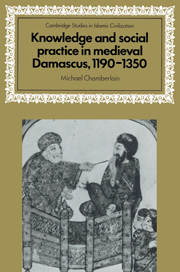Book contents
- Frontmatter
- Contents
- Preface
- List of abbreviations
- 1 Damascus and its surrounding region
- 2 Damascus in the thirteenth century
- Introduction
- 1 The acyān of Damascus, 590/1193–750/1350
- 2 Madrasas, the production of knowledge, and the reproduction of elites
- 3 Manṣabs and the logic of fitna
- 4 Social and cultural capital
- 5 Truth, error, and the struggle for social power
- Summary
- Bibliography
- Index
4 - Social and cultural capital
Published online by Cambridge University Press: 06 November 2009
- Frontmatter
- Contents
- Preface
- List of abbreviations
- 1 Damascus and its surrounding region
- 2 Damascus in the thirteenth century
- Introduction
- 1 The acyān of Damascus, 590/1193–750/1350
- 2 Madrasas, the production of knowledge, and the reproduction of elites
- 3 Manṣabs and the logic of fitna
- 4 Social and cultural capital
- 5 Truth, error, and the struggle for social power
- Summary
- Bibliography
- Index
Summary
Nothing takes longer to acquire than the surface polish which is called good manners.
Tocqueville, L'Ancien Régime et la Révolution (Paris, 1856)They are more proud of the title Cartesian and of the capacity to defend his principles than of their noble birth and blood.
Giovanni Marana, Letters Writ by a Turkish Spy (Paris, 1684)This chapter examines how the acyān, through cultivation of cilm, inculcated in their young a talent or knack for acquiring social and cultural capital. It will argue that the acyān acquired their critical loyalties and social distinction by making social use of cultural practices associated with cilm. It will argue further that where in other societies many of these practices are specialized in formal domains such as “higher education” and “book production,” in medieval Damascus they are better studied as a single group of ritual, mimetic, and performative practices.
Young people and their shaykhs
As with much else in the cultural history of Islamic societies, the association of learning with loyalty was summed up in a quotation attributed to cAlī Ibn Abī Tālib: “I am the slave of whoever who teaches me one letter of the alphabet. If he wishes he may sell me; if he so desires he may set me free; and if he cares to he may make use of me as a slave.” In quoting this sentiment, Zarnūjī was typical of his contemporaries. The acyān of Damascus constructed their most intimate and socially critical social bonds through the cultivation of cilm. Bonds of dependence and loyalty between shaykhs and their disciples, and among shaykhs themselves, were the basis of the acyān's social networks.
- Type
- Chapter
- Information
- Knowledge and Social Practice in Medieval Damascus, 1190–1350 , pp. 108 - 151Publisher: Cambridge University PressPrint publication year: 1995

